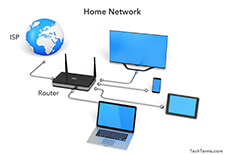HAN
Stands for "Home Area Network," which is the same thing as a home network. It is a local area network (LAN) within a home that may include both wired and wireless devices.
The central hub of a HAN is the router. In most cases, the router is connected to a modem, which communicates with an ISP. The modem provides an Internet connection to the router, which in turn provides Internet access to all connected devices within the home.
Besides sharing the same Internet connection, devices on a HAN may communicate with each other. For example, a laptop can transfer files to a desktop computer over a home network. Similarly, a smartphone can cast videos to a smart TV if they are connected to the same router.
In larger homes, a HAN may include repeaters to extend the range of the wireless signal. Both long distances and objects — especially cement walls — can cause Wi-Fi signals to degrade. A weak wireless connection may still be useable, but it may be inconsistent and produce slow data transfer rates. Wi-Fi repeaters or "mesh networks" solve this problem by boosting the signal in various areas of the home.
Previous generations of HANs mainly provided Internet access to multiple computers. Modern HANs are the foundation of smart homes, which include many connected devices besides computers. Examples include smartphones, TVs, thermostats, lights, sensors, and home assistants, such as Alexa and Google Home.
 Test Your Knowledge
Test Your Knowledge
